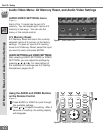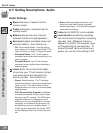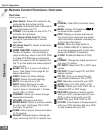
47
47
Part III: Setup
A/V Setting Descriptions: Video
Video Settings
IRIS™ is the Intelligent Room Illumi-
nation (light) Sensor. When IRIS™ is
on, your TV will automatically adjust pic-
ture contrast and brightness for best
quality (Contrast and Brightness cannot
be adjusted manually).
Contrast provides a slider to adjust
the white-to-black level. Low contrast
shows a variety of shades in darker
images, while high contrast shows
darker images more uniformly black and
makes colors appear more vibrant.
Brightness provides a slider to adjust
the overall brightness of the picture.
Sharpness provides a slider to adjust
the detail and clarity.
Color provides a slider to adjust the
color intensity.
Tint provides a slider to adjust the pro-
portion of red to green.
Color Temp (Color Temperature) allows
you to adjust how white images are dis-
played. Your choices are:
• Low 6500K or Low (for DTV): White images
will have a warm cast to them. This adjust-
ment is an average and can vary due to
ambient room lighting, video scene bright-
ness and the TV’s age. The Low 6500K
represents the 6500K industry standard for
NTSC (non-DTV) pictures.
• Medium: White images will be balanced
between the Low (warm) and High (cool)
settings.
• High: White images will have a cool cast
to them. This setting may provide the most
realistic picture under bright lighting.
Video Noise reduces minor noise (grain-
iness) in the broadcast or input signal.
Image Type maximizes the original
camera media: Video or Film. Video
media uses a video camera and is cre-
ated at 30 frames per second. Film
media uses a lm c ame r a and i s cr eat ed
at 24 frames per second. Examples of
Video media are live TV broadcast such
as news, special events, or video taped
programs. Examples of lm me di a ar e
motion pictures, made-for-TV movies,
and many prime time programs. Filmed
media is converted by the broadcaster
or home video company to 30 frames
per second to match TV or video stan-
dards. This conversion can leave subtle
“picture artifacts” or conversion errors.
Setting the Image Type to Film can
reduce the picture artifacts and improve
the picture quality, when viewing a 480i
image.
A/V Setting Descriptions: Video


















